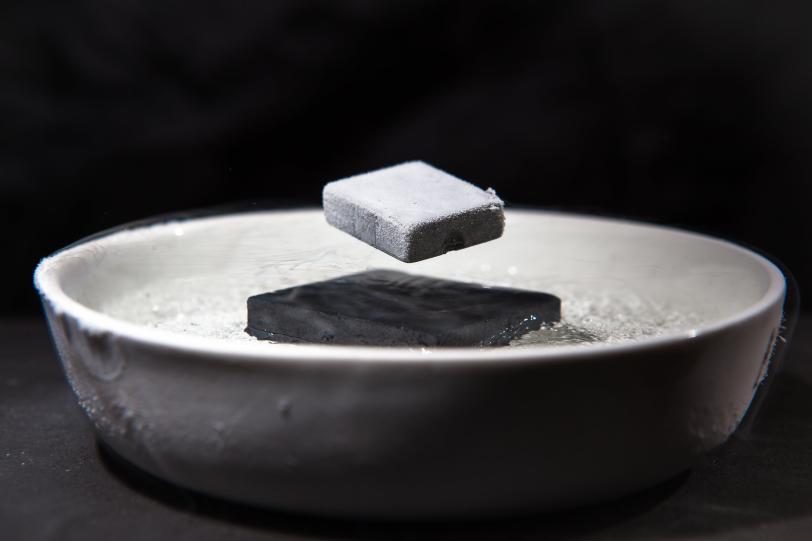Weird Superconductor Leads Double Life
Understanding strontium titanate’s odd behavior will aid efforts to develop materials that conduct electricity with 100 percent efficiency at higher temperatures.
By Glennda Chui
Until about 50 years ago, all known superconductors were metals. This made sense, because metals have the largest number of loosely bound “carrier” electrons that are free to pair up and flow as electrical current with no resistance and 100 percent efficiency – the hallmark of superconductivity.
Then an odd one came along – strontium titanate, the first oxide material and first semiconductor found to be superconducting. Even though it doesn’t fit the classic profile of a superconductor – it has very few free-to-roam electrons – it becomes superconducting when conditions are right, although no one could explain why.
Now scientists have probed the superconducting behavior of its electrons in detail for the first time. They discovered it’s even weirder than they thought. Yet that’s good news, they said, because it gives them a new angle for thinking about what’s known as “high temperature” superconductivity, a phenomenon that could be harnessed for a future generation of perfectly efficient power lines, levitating trains and other revolutionary technologies.
The research team, led by scientists at the Department of Energy’s SLAC National Accelerator Laboratory and Stanford University, described their study in a paper published Jan. 30 in the Proceedings of the National Academy of Sciences.
"If conventional metal superconductors are at one end of a spectrum, strontium titanate is all the way down at the other end. It has the lowest density of available electrons of any superconductor we know about,” said Adrian Swartz, a postdoctoral researcher at the Stanford Institute for Materials and Energy Science (SIMES) who led the experimental part of the research with Hisashi Inoue, a Stanford graduate student at the time.
“It’s one of a large number of materials we call ‘unconventional’ superconductors because they can’t be explained by current theories,” Swartz said. “By studying its extreme behavior, we hope to gain insight into the ingredients that lead to superconductivity in these unconventional materials, including the ones that operate at higher temperatures.”
Dueling Theories
According to the widely accepted theory known as BCS for the initials of its inventors, conventional superconductivity is triggered by natural vibrations that ripple through a material’s atomic latticework. The vibrations cause carrier electrons to pair up and condense into a superfluid, which flows through the material with no resistance – a 100-percent-efficient electric current. In this picture, the ideal superconducting material contains a high density of fast-moving electrons, and even relatively weak lattice vibrations are enough to glue electron pairs together.
But outside the theory, in the realm of unconventional superconductors, no one knows what glues the electron pairs together, and none of the competing theories hold sway.
To find clues to what’s going on inside strontium titanate, scientists had to figure out how to apply an important tool for studying superconducting behavior, known as tunneling spectroscopy, to this material. That took several years, said Harold Hwang, a professor at SLAC and Stanford and SIMES investigator.
“The desire to do this experiment has been there for decades, but it’s been a technical challenge,” he said. “This is, as far as I know, the first complete set of data coming out of a tunneling experiment on this material.” Among other things, the team was able to observe how the material responded to doping, a commonly used process where electrons are added to a material to improve its electronic performance.
‘Everything is Upside Down’
The tunneling measurements revealed that strontium titanate is the exact opposite of what you’d expect in a superconductor: Its lattice vibrations are strong and its carrier electrons are few and slow.
“This is a system where everything is upside down,” Hwang said.
On the other hand, details like the behavior and density of its electrons and the energy required to form the superconducting state match what you would expect from conventional BCS theory almost exactly, Swartz said.
“Thus, strontium titanate seems to be an unconventional superconductor that acts like a conventional one in some respects,” he said. “This is quite a conundrum, and quite a surprise to us. We discovered something that was more confusing than we originally thought, which from a fundamental physics point of view is more profound.”
He added, “If we can improve our understanding of superconductivity in this puzzling set of circumstances, we could potentially learn how to harvest the ingredients for realizing superconductivity at higher temperatures.”
The next step, Swartz said, is to use tunneling spectroscopy to test a number of theoretical predictions about why strontium titanate acts the way it does.
SIMES is a joint SLAC/Sanford institute. Theorists from SIMES and from the University of Tennessee, Knoxville also contributed to this study, which was funded by the DOE Office of Science and the Gordon and Betty Moore Foundation’s Emergent Phenomena in Quantum Systems Initiative.
Citation: A. Swartz et al., PNAS, 30 January 2018 (10.1073/pnas.1713916115)
For questions or comments, contact the SLAC Office of Communications at communications@slac.stanford.edu.
SLAC is a multi-program laboratory exploring frontier questions in photon science, astrophysics, particle physics and accelerator research. Located in Menlo Park, Calif., SLAC is operated by Stanford University for the U.S. Department of Energy's Office of Science.
SLAC National Accelerator Laboratory is supported by the Office of Science of the U.S. Department of Energy. The Office of Science is the single largest supporter of basic research in the physical sciences in the United States, and is working to address some of the most pressing challenges of our time.






